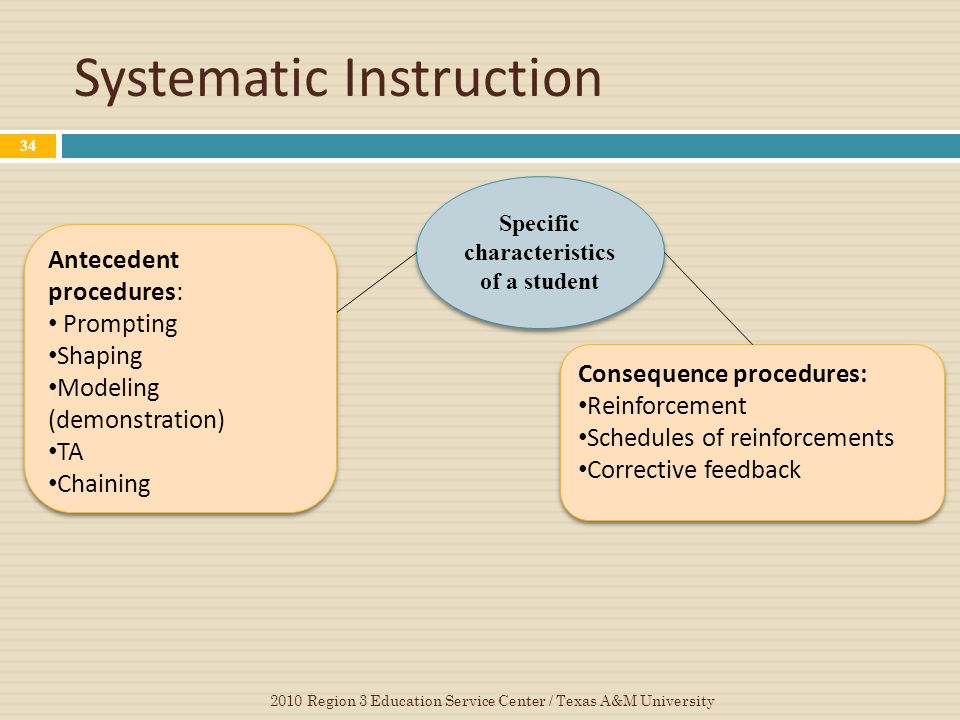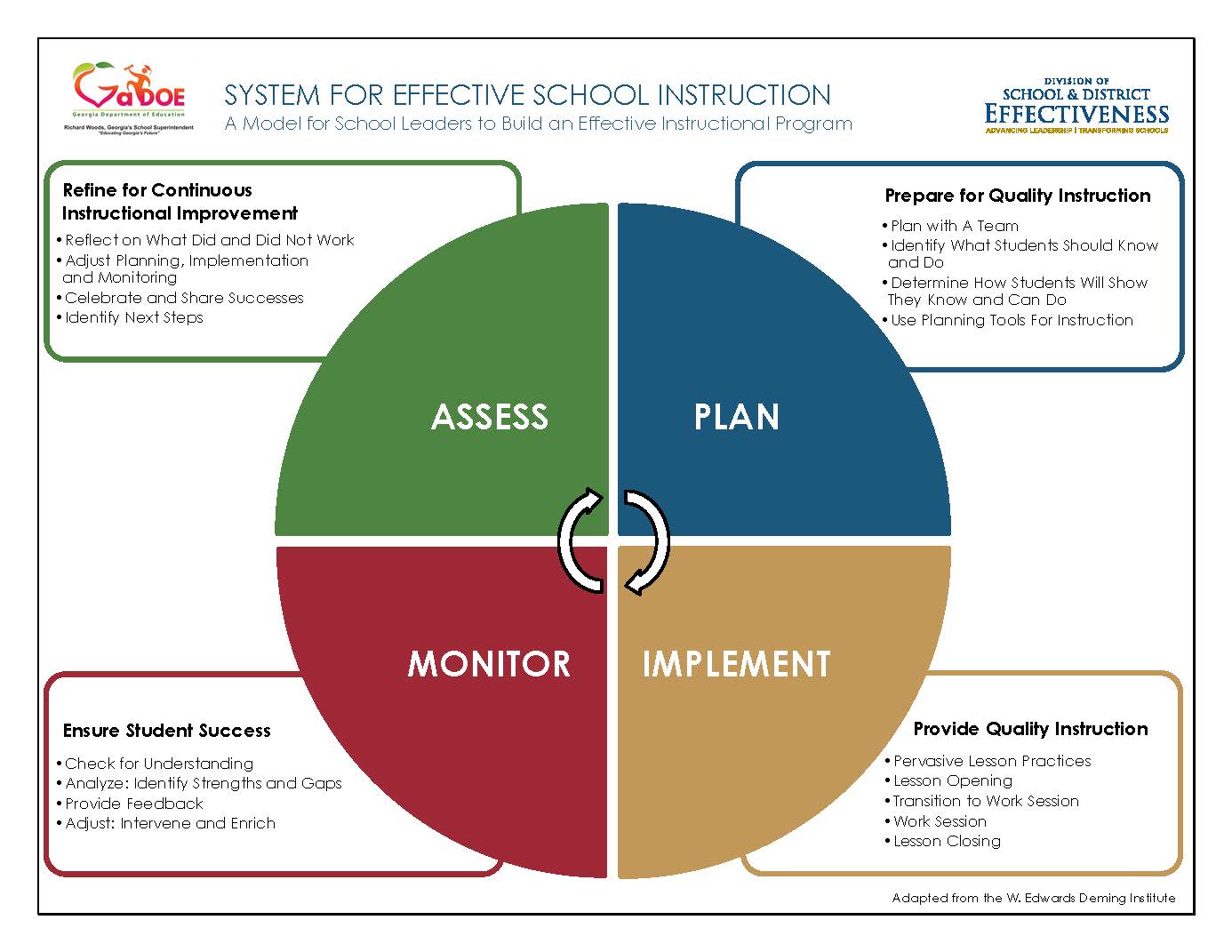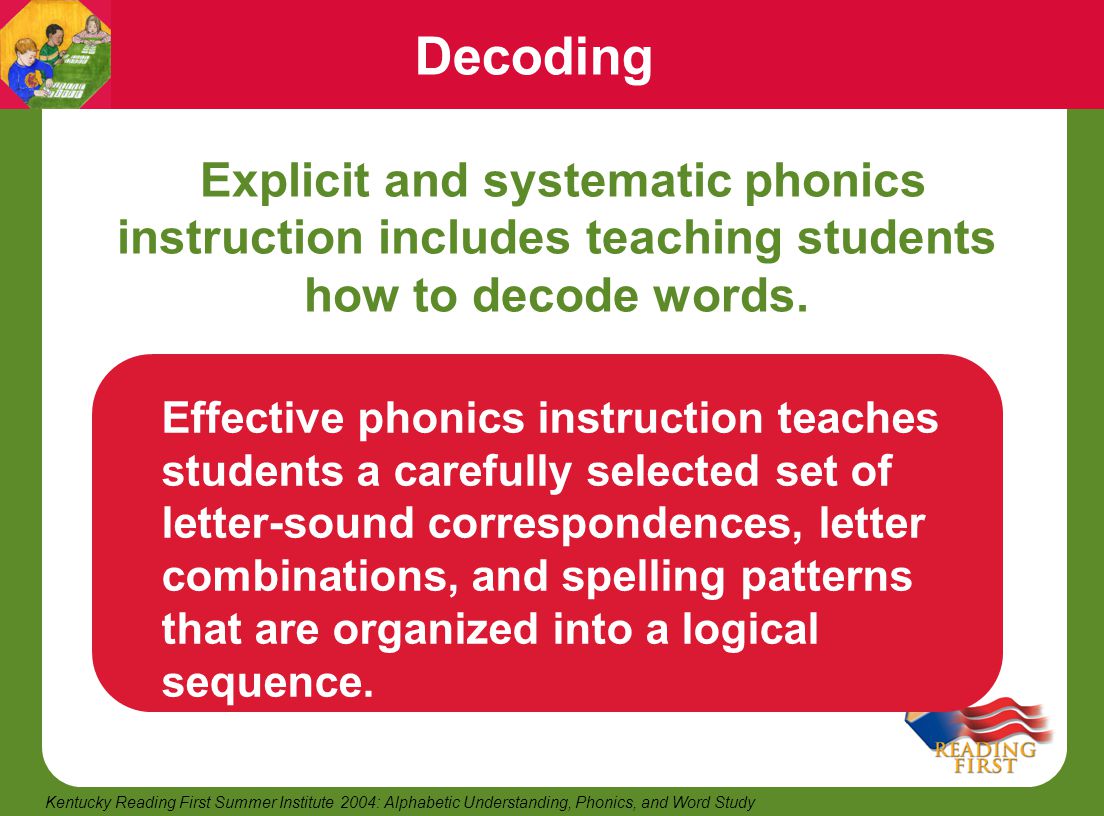Training in Systematic Instruction TSI, Cardiff. 348 likes 20 talking about this. Contact Mark Kilsby on or email kilsbyms@yahoo. uk Systematic phonics instruction is a method of teaching reading that introduces sound units and sight words one at a time. What does systematic phonics instruction look like. The process of systematic instruction for handicapped and nonhandicapped students involves eight steps: assessment, establishment of long term objectives, establishment of short term objectives, development of an instructional plan, development of measurement procedures, implementation of the plan and measurement, data based modification of the plan, and evaluation of overall pupil progres. Training in Systematic Instruction TSI. Training in Systematic Instruction TSI. Sp S on S so S red S December 4, 2017 Language is so important. Remember 'people first' language is always best we need to get better at not lumping people together with language that labels and compounds negative stereotypes. Systematic synthetic phonics instruction had a positive and significant effect on helping disabled readers, low achieving students, and students with low socioeconomic status to read words more effectively than instruction methods that lacked this approach. Effective, enjoyable, systematic phonics instruction involves many subroutines that are all practiced in this module. In this one day training, the sequence and substance of concept development in codebased instruction is emphasized, including the importance of applying learned skills to. Systematic Instruction Research has found that students that struggle with reading have working memory issuesthus, the ability to filter, categorize, and prioritize information is very difficult for struggling students. Systematic instruction is a more descriptive term than direct instruction and is less ambiguous. Information processing research The research on human cognitive architecture, on how information is acquired, stored and retrieved. This video expands the superficial understanding of the word systematic as it it applied to instruction in reading. Training in Systematic Instruction (TSI) is a structured approach to teaching vocational and independent living skills to people with intellectual disabilities. TSI has an emphasis on errorless learning and encourages decisionmaking by people with a learning disability enabling them to learn complex tasks. What is systematic instruction? Systematic instruction is a method of teaching where the same set of procedures is used over and over on a continuous basis to teach the same information or a specific skill. Systematic Instruction Other than Supported Employment. The purpose of Systematic Instruction is to provide customized oneonone support to assist DVR consumers on the job site. Systematic Instruction may consist of help learning the job, talking through Systematic Instruction is following a sequence of development for language and reading acquisition. This instruction should be carefully thoughtout, strategic and designed before activities and lessons planned. Page 4: Explicit, Systematic Instruction Explicit, systematic instruction, sometimes simply referred to as explicit instruction, involves teaching a specific concept or procedure in a highly structured and carefully sequenced manner. The Pathway from Discovery to Job Development: Essential Steps for Customized Employment Success Duration: 1: 05: 40. VCU RRTC 2, 473 views Training in Systematic Instruction (TSI) is a teaching approach we use that presupposes everyone, no matter the disability, has the right to learn skills. As the name suggests, TSI argues that learning will happen when a person is motivated to learn and if the opportunity to do so is carefully managed in a planned and systematic fashion. Three preservice teachers of students with severe disabilities were trained on systematic instruction skills, focusing on appropriate use of positive consequences and instructional prompts. Results indicated that immediate feedback was more effective with two student teachers and delayed feedback was more effective for the third. Teaching skills were maintained at follow up. Provide intensive, systematic instruction on up to three foundational reading skills in small groups to students who score below the benchmark on universal screening. Typically, these groups meet between three and five times a week for 20 to 40 minutes (tier 2). Instructional design (ID), or instructional systems design (ISD), is the practice of creating instructional experiences which make the acquisition of knowledge and skill more efficient, effective, and appealing. The process consists broadly of determining the state and needs of the learner, defining the end goal of instruction, and creating some intervention to assist in the transition. Systematic instruction is an evidencebased method for teaching individuals with disabilities that spans more than 50 years. It incorporates the principles of applied behavior analysis and allows for educators to teach a wide range of skills, including everything from academic to functional living skills. Systematic phonics instruction results in better growth in children's ability to comprehend what they read than nonsystematic or no phonics instruction. This is not surprising because the ability to read the words in a text accurately and quickly is highly related to successful reading comprehension. Systematic Design of Instruction is a instructional systems design modelmethod; Of course, Systemtic design of instruction could refer any kind of systematic design concept, but in this article we refer to it as the name of a design methodology that is suggested by Dick Carey (2004). Systematic instruction is an evidencebased method for teaching individuals with disabilities that spans more than 50 years. It incorporates the principles of applied behavior analysis and allows for educators to teach a wide range of skills, including everything from academic to functional living skills. SYSTEMATIC INSTRUCTION Part II Antecedent and Consequence Procedures 2010 Region 3 Education Service Center Texas AM University Say: Here is an example of using. Effective Job Coaching Supports: Using Both Natural Supports and Systematic Instruction John Butterworth Melanie Jordan Institute for Community Inclusion UMass Boston Systematic Instruction Applied to ATC. Reviews of the literature indicate that instruction in the use of external aids and, in particular, ATC is rarely or inconsistently reported in the research (deJoode et al. This trend is mirrored in clinical practice. The plan for systematic instruction is carefully thought out, strategic, and designed before activities and lessons are developed. Systematic instruction is clearly linked within, as well as across the five major areas of reading instruction (phonemic awareness, phonics, fluency, vocabulary, and comprehension). Explicit Systematic Phonics The purpose of phonics instruction is to teach children soundspelling relationships and how to use those relationships to read words. Phonics instruction should be explicit and systematic. It is explicit in that soundspelling Systematic Instruction: A carefully planned sequence for instruction, similar to a builders blueprint for a house characterizes systematic instruction. A blueprint is carefully thought out and designed before building materials are gathered and construction begins. Systematic instruction is an approach to instruction based the principles and research of Applied Behaviour Analysis (also called ABA). ABA is based on a large body of rigorous scientific research over the last half century on the principles of learning. SELN Systematic Instruction Series with Teri Johnson During the series, Teri Johnson explained how systematic instruction evolved in response to widely accepted and devastating beliefs and attitudes. With the adoption of systematic instructions, individuals with disabilities can improve job performance and increase their autonomy. The Systematic Activities for Scripted Systematic Instruction offer intensive instruction needed to move toward mastery of the Core Content Connectors. These activities provide teaching scripts for teachers who may not have extensive training in systematic instruction. Training in Systematic Instruction Courses, TSI Courses, Dr Mark Kilsby and Julie Allan Systematic Instruction Plans Systematic instruction plan (SIP) is serves as a written description of exactly how a skill will be taught. SIP allows all instructors to know exactly how to teach each skill to each student ensuring that everyone is using the same strategies. The first chapter of this course provides a brief review from part 1, covering the basics of memory theory that are relevant to systematic instruction, and providing an overview of a systematic instruction framework implemented in the proceeding chapters. Systematic instruction plan (SIP) is designed to serve as a written description of exactly how a skill will be taught. The idea behind a SIP is that it allows all instructors to know exactly how to teach each skill to each student ensuring that everyone is using the same strategies. (B2BBISI), as appropriate, or an agent thereof, in accordance with the instructions on the attached Systematic Instruction Form (Form) to make: a)he deposits to myour Bank Account or myour B2BBDS Account (including myour B2BBDS Investment Account and B2BBDS TFSA Account) ( t The Systematic Instruction Organisation provides TSI training for staff and parents of people with disabilties, enabling them to provide a range of skills training which lead to inclusion in the world of work and community living settings. The organisation is led by Geoff Warner, who has had many years of experience in the field of disablity. having, showing, or involving a system, method, or plan: a systematic course of reading; systematic efforts. given to or using a system or method; methodical: a systematic person. arranged in or comprising an ordered system: systematic theology. Presentations that explain the concepts and instructional techniques found in the MASSIs can be found in the Educator Professional Development and Parent Resources. McKay Sohlberg is the first in a twopart series exploring systematic instruction for patients experiencing acquired memory and learning impairments. Structured Literacy instruction is systematic and cumulative. Systematic means that the organization of material follows the logical order of the language. Systematic means that the organization of material follows the logical order of the language. A phonicsbased reading curriculum in which students used an iPad to respond was created for students with developmental disabilities not able to verbally participate in traditional phonics instruction due to their use of augmentative and assistive communication. Transcript: Explicit, Systematic Instruction: Elementary. Narrator: In this video, the teacher uses explicit, systematic instruction. During the first step of explicit, systematic instruction, the teacher readies the students for the lesson. Systematic Instruction is a type of employment supports provided by paid service provider staff to assist DVR consumers on the job site and may include assistance with logistics of getting to the job site. In systematic instruction, the students acquire the skills, and in project work, they apply those skills in meaningful contexts. Project work can thus be seen as the part of the curriculum planned in negotiation with the students and supportive of (and extending) the. EvidenceBased Practices for Students With Severe Disabilities. Browder Leah Wood Julie Thompson University of North Carolina at Charlotte. Cecelia Ribuffo University of Florida. August 2014 CEEDAR Document No. Direct, Explicit, and Systematic Instruction Submitted by jaspar on Mon, 12: 21 These evidencebased tips will help teachers promote effective reading instruction for all students. Introduction Good teachers understand that for a child to learn, the teaching style must match the students learning style..











